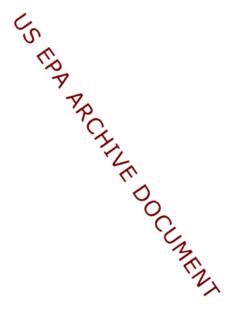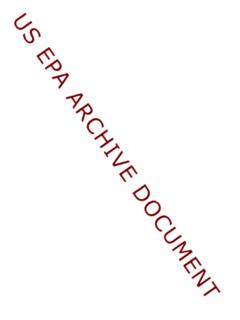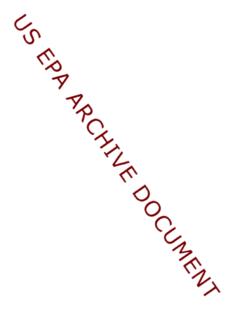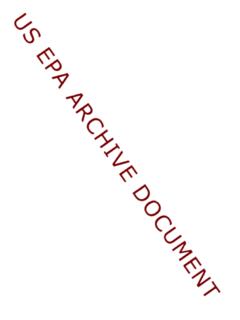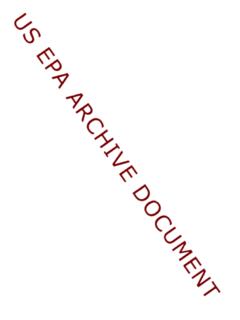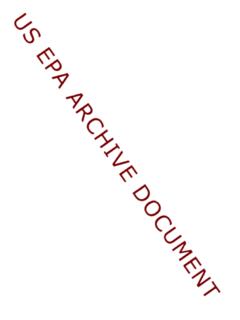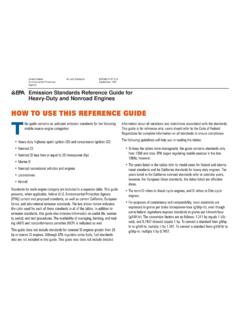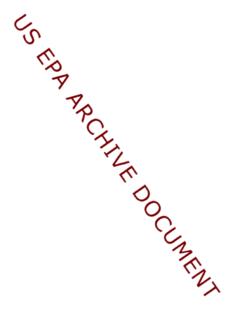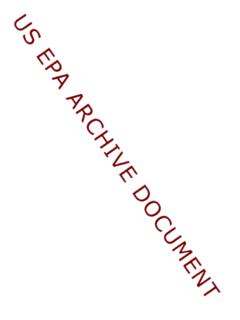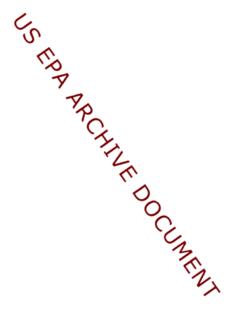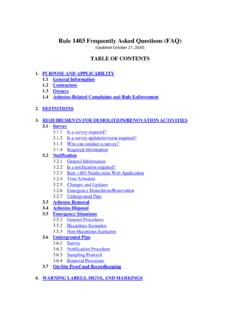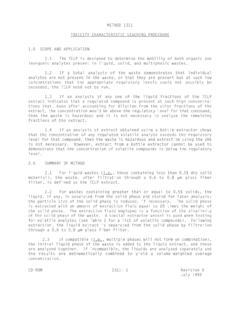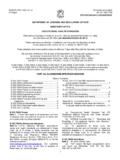Transcription of Session 9: RCRA Hazardous Waste Identification ...
1 1 Session 9 Session 9 RCRA Hazardous Waste RCRA Hazardous Waste Identification : Identification :Characteri stic Hazardous WasteCharacteristic Hazardous Waste2 Agenda: Characteristic Hazardous Waste Hazardous Waste Identification (HWID) review Characteristic determination and testing Ignitability Corrosivity Reactivity Toxicity Summary3 First Half Review Difference between the Hazardous Waste listings and characteristics The four listings and what they represent Difference between the P and U lists Four steps to the Hazardous Waste Identification processHWID Review Can anyone explain to me the main (historical) difference between listings and characteristics? Listings are based on Pedigree ( , history, background, derivation) VS. Characteristics are based onchemistry ( , physical properties) What are the four types of listings and what do they represent? F nonspecific, K specific, P acute CCPs, and U toxic CCPs What is the difference between P and U lists?
2 Acute vs. Toxic. What are the first (3) three steps of the HWID process?Is it a Solid Waste , is it Excluded, and is it Listed. And the fourth?Is it characteristic?4 First Half Review The four listing categories are F, K, P, and U - F list, non-specific sources - K list, specific sources (e) and (f) - P and U lists, discarded, unused commercial chemical products The four steps in the HWID process are:1. Is the material a solid Waste ? 2. Is it excluded? 3. Does the Waste meet a Hazardous Waste listing? 4. Does the Waste exhibit a Hazardous Waste characteristic?HWID Review5A generator must determine if solid Waste is a Hazardous Waste Representative sample Characteristics Test versus knowledgeCharacteristic determination and Testing6 There are four Hazardous Waste characteristics determination and Testing These are the 4 HW Characteristics They are found in sections The above pictures give a good illustration of what they are.
3 Something flammable or causing fire Something that cancause rust or decomposition Something explosive Something poisonous Before get into details, Where does it tell us we have to determine characteristics? Why? How?7A generator must determine if the Waste exhibits a characteristic Characteristic determination is accomplished by Testing the Waste with the specified test method Applying knowledge of the hazard characteristic in light of the materials or process used Acceptable knowledge includes process knowledge and records of analysis (c)Characteristic determination and Testing 40 CFR (c)explains that generators have two optionsfor determining if their Waste is By either testing their Waste or applying their knowledge. Acceptable Knowledge is broadly defined to include process knowledge, and the facility s records of analysisperformed before the effective date of RCRA regulations or actual chemical analysis of the Waste .
4 Process knowledgeincludes detailed information about the Waste obtained from existing published or documented Waste analysis data or studies conducted on wastes generated by processes similar to that which generated the Waste in question. 8A characteristic determination must be made in two instances If the Waste is not listed in Subpart D of Part 261 ( , the lists of Hazardous wastes) Even if the Waste is listed, the generator must determine if the Waste exhibits a characteristic in order to comply with land disposal restrictions (LDR) in 40 CFR Part 268 (c)Characteristic determination and Testing9 The generator must take a representative sample to test Waste A representative sample is a sample of a universe or whole expected to exhibit the average properties of the universe or whole Appendix I, Part 261, contains sampling methods that are representative The SW-846 test methods manual explains how to test samples of Waste determination and Testing Generators are required to take representative samples of their wastestream for identifying the characteristics.
5 Can anyone think of where we might find a definition of representative sample?Recall that most definitions are in section Representative Samplemeans a sample of a universe or whole ( , Waste pile, lagoon, ground water) which can be expected to exhibit the average properties of the universe or whole (40 CFR Sec. ). In other words, a sample is representative if it is a collection or portion of a wastestream that demonstrates the composition of the whole ignitability characteristic (D001) applies to wastes that are: Liquids with a flash point less than 60 C (140 F) Solids that spontaneously combust and burn vigorously and persistently Ignitable compressed gases and oxidizers as defined by the Department of Transportation (DOT) regulations Examples: solvents, fuels, degreasers 1stFORM = LIQUIDS THAT HAVE FLASH POINT OF LESS THAN 60 C or 140 F Examples:gasoline, benzene, alcohols, acetone, What is a flash point?
6 Flash point is the lowest temp at which fumes above a Waste ignite when exposed to flame Test Method 1311 Pressure Filtration technique is the definitive method for determining if Waste is a liquid AQUEOUS = 50% WATER BY WEIGHT (July 1992 Monthly Report Question.) ALCOHOL EXCLUSION less than 24% alcohol by volume (July 1992 Monthly Report Question.) 2nd FORM = IGNITABLE SOLIDS Example - magnesium tape, and other thermally unstable solids that spontaneously ignite To exhibit the characteristic the Waste must meet both parts of the defnition: 1. Cause fire thru friction etc.; and 2. Burn vigorously & persistently (See December 9, 1999 memo)- Test Method 1030 can be used for 2nd part but not 1st. Therefore, must apply knowledge to know if Waste meets 1stpart. LAST 2 FORMS ARE OXIDIZERS & COMPRESSED GASES Both are defined by DOT the following wastes ignitable?
7 A liquid with a flash point of 150 F Rubbing alcohol with 10% alcohol by volume Paint thinner containing 36% water by weight and a flash point of 44 C 1 No. Flashpoint of more than 140 F. 2 No. There is more than 50% water, therefore it is aqueous, and less than 24% alcohol, therefore the alcohol exclusion applies. 3 Yes. The flashpoint is less than 60C and it is not aqueous because water content is less than 50%.12 The corrosivity characteristic (D002) applies to wastes that are: Aqueous solutions with a pH of less than or equal to 2 or greater than or equal to Liquids that corrode steel The corrosivity characteristic does not apply to solids Examples include: rust removers, alkaline cleaning fluids, battery acid Why would EPA want to regulate wastes that are corrosive?
8 Corrosive wastes eat through things and make containers more susceptible to leaking and escape. Examples of corrosive wastes?Hydrochloric acid, nitric acid, sulfuric acid; ammonium hydroxide, sodium hydroxide Wastes are corrosive because they are either highly acidic or highly basic. Just like the ignitablity characteristic, EPA determines whether something is corrosive based on formas well as the way in which it is testedto determine if it is corrosive. The first formis aqueous(a different definition from what applies to D001). Aqueous includes those wastes which are amenable to pH in other words this means that these types of wastes contain enough water to be able to measure pH .. generally 20%of the total volume of the Waste . secondly, EPA looks at liquid wastes that can corrode steel thirdly, unlike ignitable wastes EPA has yet to characterized solids as short memo from August 18, 1987 explains this.
9 There is no definition of a corrosive solid, therefore EPA does not recognize corrosive the following wastes corrosive? Battery acid with a pH of Steel wool with a pH of 2 Liquid lime-based floor cleaner with a pH of Yes. The pH is < What Waste code does it carry? D002 No. There is no such Waste as a corrosive solid. What Waste code? None Not according to paragraph 1 of the regulations, because it is below the pH level of , however it could be corrosive according to the second paragraph, the steel corrosion rate. Our example doesn t give the steel corrosion rate for the floor cleaner. What if the rate was mm per year at a test temperature of 130F according to the specified test method?? Would it then be d002? YES. 14 The reactivity characteristic (D003) applies to the following Waste Normally unstable and readily undergoes violent change without detonating Reacts violently or forms potentially explosive mixtures with water Releases toxic gases when mixed with water Is a cyanide or sulfide bearing Waste that releases toxic gases when exposed to pH conditions between 2 and They are those which are Hazardous because of their extreme instability and tendency to react violently or explode.
10 What are some examples that you can think of reactive wastes .. how about things like explosives, or materials under high pressure such as compressed let s look at the properties that make a Waste reactive .. do these look like things that are easily testable using standardized methods? No, there are too many conditions or situations that could cause something to be reactive. This is why EPA relies on a narrative description of reactivity. EPA tried to put forth a numerical basis for cyanide and sulfide bearing but in 1998, after the testing guidance was re-evaluated, they withdrew it. Therefore, EPA relies on generator knowledgeto determine if their Waste is reactivity characteristic (D003) applies to the following Waste (cont.) Capable of detonation or explosive reaction if subjected to a strong initiating force or if heated under confinement Is readily capable of detonation or explosive decomposition or reaction at standard temperature and pressure Is a forbidden explosive under DOT toxicity characteristic (TC) is based on the potential of a Waste to contaminate groundwaterToxicity The TC is different from the first three characteristics because the harm that they can cause is immediate and firsthand.
